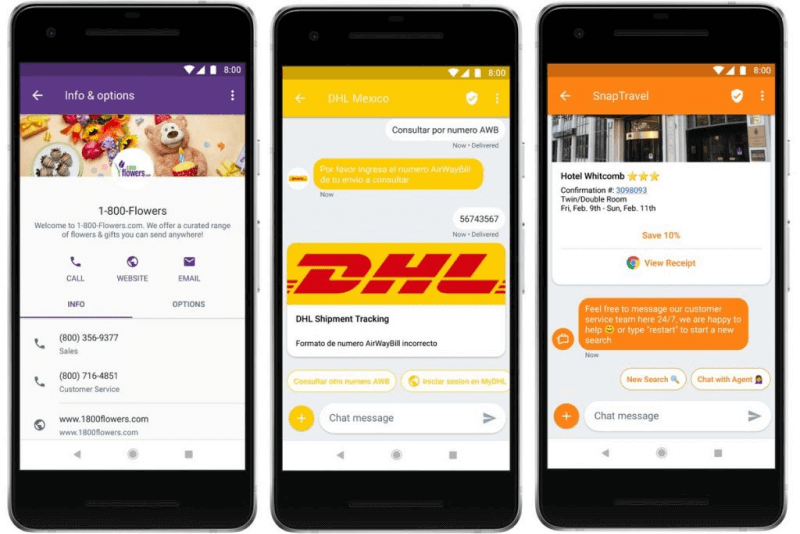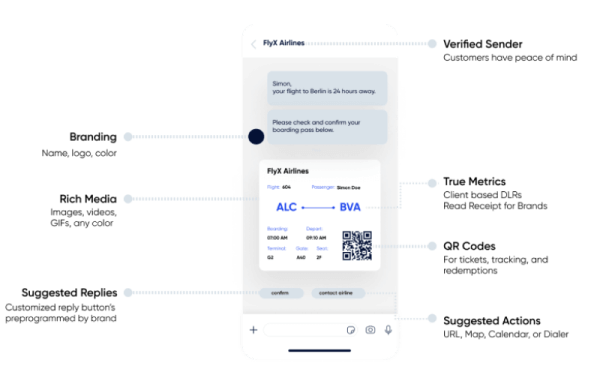RCS messaging for rich, personalized engagement
Text messaging has been a powerful tool for communication for businesses much before Whatsapp and its likes came into being. The number of feature phones still outnumber smartphones, making SMS (short message service) the preferred communication tool for businesses to engage with their customers. Over the last couple of decades, SMS has been the key driver and an efficient channel for customer engagement for brands. Be it an eCommerce brand sending you an order confirmation message, a bank confirming your cash transaction, or a travel business sharing your ticket, SMS has been a ubiquitous channel of communication for brands.
Updated on Sep 29, 2020
According to Ericsson, in 2019, there were 7.9 billion mobile subscriptions worldwide. The stats only point towards a prospect pool which is enabled to receive SMS and may or may not be using internet connectivity. SMS definitely would be a marketers delight, look at these stats:
- SMS has a whopping 98% open rates
- 90% of all the texts sent are read or at least glanced upon within 3 minutes, and nearly 32% of the customers respond to the SMS offers.
- In 2017, 28,000 messages were sent every second of every day, for an entire year.
With such staggering open rates and success why do you need to upgrade from SMS?
Technology advancement has heralded the rise in changing customer expectations. The new customers, which comprises millennials, prefer to interact with brands in totally different ways. They are spoilt for choice and used to communication and targeting that’s tailor-made for them. These are the customers who desire interactivity and higher levels of engagement, personalization, and services from their most loved brands. This is where SMS as a medium falters because of certain inherent limitations with its technology.
However, today SMS is not the only messaging service that’s popular among brands. Texting has become so popular today that often it’s the preferred mode of communication vis-a-vis a call. It’s not surprising that messaging apps like WhatsApp and Facebook Messenger, with over 1.5 billion users each, compete in a crowded market with other services namely iMessage, WeChat, Slack, Skype, Viber, Android Messages, and many others. The experience provided to customers using these messaging apps is fundamentally built on the functionalities of SMS such as instant messaging with emojis, multimedia file sharing, and group chats for coherent engagement.
The enormous popularity of messaging apps is perfect for any brand that is looking to engage with its customers in increasingly adherent ways. With more apps in the market, the instant messaging landscape is fragmented. In order to support customers across a crowded messaging ecosystem, developers constantly tussle with variations in APIs, and capabilities. Keeping up has proven to be difficult, time-consuming, and — most important — costly. This is where RCS comes into the picture.
What is RCS Messaging?
Rich Communication Services or RCS is hailed as the next generation of SMS that offers a rich and personalized experience that aims to drive increased customer engagement.
Rich features like high-resolution photo and video sharing, mapping directions, location sharing, typing indicators, the ability to add and remove members to group chats, and so much more, are delivered to a device’s default messaging app irrespective of the network the user is on.

What are the Features of RCS Messaging?
Brands have yearned for a standalone messaging service like iMessage for their Android users. With RCS messaging, brands can deliver a seamless experience using the power of personal and interactive messaging along with some of the key features of Apple’s iMessage which includes read receipts, ability to send rich media and many more.
Apart from the iMessage features, brands can experience some more exciting features that the Apple messaging platform doesn’t provide:

- Brand Customization – RCS allows the messaging channel to customize, including adding company logos, independent brand colors, and brand fonts to create a more familiar messaging environment for your customers.
- Verified Status – In today’s world, customers find it hard to decipher whether they are interacting with the genuine brand or being scammed by a close fake brand. To solve this problem, RCS has a verified badge that helps you in reassuring the customer that they are engaging with the official brand.
- Rich Media – Unlike SMS, you can now send high-resolution images and rich cards to deliver a far more engaging experience that increases your conversion rates.
- CTA like Response Buttons – Getting customers to react in the moment helps to secure higher revenues and boost up conversions. With interactive in-message, you can suggest specific actions and predefined replies via CTA buttons, which helps in getting the users to react to your message right in the moment.
- Read Receipts (Double Ticks) – Allow customers to learn and optimize their messaging strategies via delivery and read receipts
- A New Channel for Customer Journey – Combine with other Insider channels for a comprehensive communication strategy.
What are the benefits of RCS Messaging?
With great features come great benefits. RCS messaging poses a huge opportunity for you to reach out to customers in a more individualized and interactive way.
- Rich Communication – With rich media, you are bound to improve customer engagement as the communication is packaged for capturing eyeballs and elicit response.
- Fallback Mechanism – With RCS, you have a fall-back option of an SMS or MMS landing page. If a customer’s phone does not support business RCS, the technology allows it to automatically turn into an MMS or SMS to make sure your messages reach them.
- Engagement Data – As RCS supports read receipts you can track engagement data such as reads to click through ratio.
- Build Greater Trust – By featuring verified user and branding ID credentials you can get more subscribers with increased trust and reduce spam messages.
- Increased Customer Retention – RCS enables you to offer more engaging, personalized customer journeys thus helping in creating a meaningful relationship with your customers by leveraging communication.
The Way Forward
According to the latest IDC figures, Android had an 85% market share of the 1.5 billion new smartphones shipped in 2018. Crucially, Android OEMs like Samsung, LG, and Huawei support RCS, so via the usual two-year renewal cycle of smartphones, RCS will grow significantly as a native function of nearly all new Android devices – with an installed user base of approximately five billion globally. A prediction by research analysts, Mobilesquared says a total of 1.01 billion people will use RCS messaging across 168 mobile operators around the world by the end of 2019. They estimate that this number will grow to 3.23bn across 486 mobile operators by the end of 2023.
With such a growing ecosystem of Google, mobile network operators, OEMs, and dozens of messaging companies, RCS will turn mainstream and be available for everyone. This also draws a huge potential for RCS to complement channels that are already widely used such as WhatsApp business API and messenger.
Watch this space for more news and updates on RCS messaging.
Insider has a novel Push Amplification solution that acts as a backup to standard notification gateways and delivers notifications directly to a user’s phone when standard delivery fails.



















